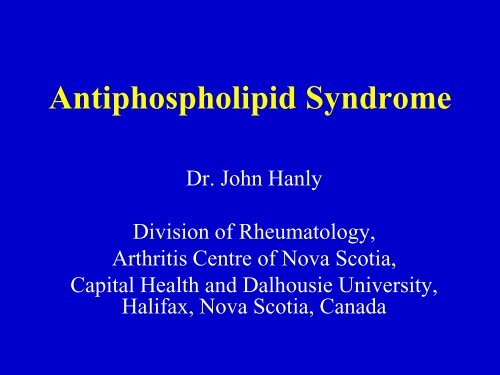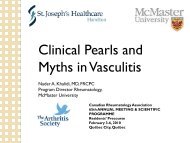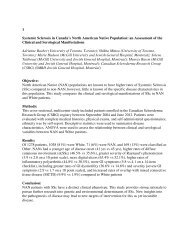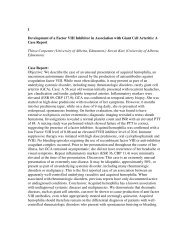Antiphospholipid Syndrome.
Antiphospholipid Syndrome.
Antiphospholipid Syndrome.
Create successful ePaper yourself
Turn your PDF publications into a flip-book with our unique Google optimized e-Paper software.
<strong>Antiphospholipid</strong> <strong>Syndrome</strong><br />
Dr. John Hanly<br />
Division of Rheumatology,<br />
Arthritis Centre of Nova Scotia,<br />
Capital Health and Dalhousie University,<br />
Halifax, Nova Scotia, Canada
Disclosures<br />
• Peer-reviewed grants (current)<br />
CIHR, Capital Health<br />
• Unrestricted grants from industry<br />
Abbott, Roche, Schering, UCB<br />
• Clinical trials<br />
Abbott, UCB<br />
• Advisory boards<br />
UCB, Roche, GSK
<strong>Antiphospholipid</strong> <strong>Syndrome</strong><br />
Objectives<br />
• Definition antiphospholipid syndrome (APS)<br />
• Laboratory detection of aPL antibodies<br />
• Pathogenesis and clinical manifestations<br />
• Case presentations and treatment
<strong>Antiphospholipid</strong> Antibodies<br />
Measurement<br />
Binding assays<br />
(ELISA)<br />
Functional<br />
coagulation assays<br />
• Anticardiolipin<br />
• VDRL<br />
• Lupus anticoagulant<br />
(LAC ratio)
(Hanly JG CMAJ 2003;168(13):1675)
IgG Anticardiolipin Antibodies<br />
(((Hanly et al J Rheum 1996; 23:1543)
Phospholipid-binding<br />
Proteins<br />
• Initially called “cofactors”<br />
• Ubiquitous serum proteins<br />
• 2 -glycoprotein I<br />
Prothrombin<br />
Protein C<br />
Protein S<br />
Annexin V
(Hanly JG CMAJ 2003;168(13):1675)
Lupus Anticoagulant<br />
International Criteria<br />
• Prolongation of phospholipid-dependent<br />
coagulation assay (e.g. RVVT, PTT, KCT)<br />
• Failure to correct inhibition of in-vitro<br />
coagulation with normal plasma (“50:50 mix”)<br />
• Correction of inhibition of in-vitro coagulation<br />
with exogenous phospholipid<br />
(Brandt JT et al. Thromb Haemost 1995;74:1185)
Lupus Anticoagulant<br />
(Hanly JG CMAJ 2003;168(13):1675)
<strong>Antiphospholipid</strong> Antibodies (aPL)<br />
• Autoimmune aPL:<br />
- Persistent<br />
- Associated with clinical sequelae<br />
• Infection-related aPL:<br />
- Transient<br />
- Not associated with clinical sequelae<br />
• Routine laboratory assays do not readily<br />
distinguish between them
<strong>Antiphospholipid</strong> antibodies<br />
When to consider<br />
• Unexplained venous or arterial thrombosis<br />
• Recurrent fetal loss<br />
• Thrombocytopenia<br />
• Hemolytic anemia<br />
• Systemic lupus erythematosus<br />
• Prolonged phospholipid dependent<br />
coagulation test
<strong>Antiphospholipid</strong> <strong>Syndrome</strong><br />
Classification Criteria (Sapporo)<br />
• Clinical manifestation:<br />
- Vascular thrombosis (venous or arterial)<br />
- Pregnancy morbidity<br />
3 consecutive losses < 10 weeks gestation<br />
1 loss 10 weeks gestation<br />
1 premature births 34 weeks gestation<br />
• Laboratory criteria:<br />
- Anticardiolipin antibody (med/high IgG or IgM)<br />
- Lupus anticoagulant<br />
(positive test 2 occasions 6 weeks apart)<br />
(Wilson WA et al. Arthritis Rheum 1999;42:1309)
<strong>Antiphospholipid</strong> <strong>Syndrome</strong><br />
Modification of Sapporo Criteria<br />
• Clinical manifestation:<br />
- Vascular thrombosis (venous or arterial)<br />
- Pregnancy morbidity<br />
3 consecutive losses < 10 weeks gestation<br />
1 loss 10 weeks gestation<br />
1 premature births 34 weeks gestation<br />
• Laboratory criteria:<br />
- Anticardiolipin antibody (med/high IgG or IgM)<br />
- Lupus anticoagulant<br />
- Anti- 2 -GPI<br />
(positive test 2 occasions 12 weeks apart)<br />
(Miyakis et al , J Thromb Haemost, 2006;4:295)
<strong>Antiphospholipid</strong> <strong>Syndrome</strong><br />
Pathogenic Mechanisms<br />
(Hanly JG. CMAJ 2003;168(13):1675)
<strong>Antiphospholipid</strong> <strong>Syndrome</strong><br />
Pathogenic Mechanisms<br />
(Hanly JG. CMAJ 2003;168(13):1675)
<strong>Antiphospholipid</strong> <strong>Syndrome</strong><br />
Pathogenic Mechanisms<br />
(Hanly JG. CMAJ 2003;168(13):1675)
<strong>Antiphospholipid</strong> <strong>Syndrome</strong><br />
Pathogenic Mechanisms<br />
(Hanly JG. CMAJ 2003;168(13):1675)
<strong>Antiphospholipid</strong> <strong>Syndrome</strong><br />
Pathogenic Mechanisms<br />
(Hanly JG. CMAJ 2003;168(13):1675)
Blockade of C5a-c5a Receptor Prevents<br />
aPL Antibody-induced Fetal Loss in Mice<br />
- Uteri from 15 day pregnancies in mice<br />
- aPL: antiphospholipid antibody<br />
- NH-IgG: normal IgG<br />
- C5aR-AP: C5a receptor antagonistic peptide<br />
(Girardi G et al, J Clin Invest 112:1644-1654; 2003)
Thrombosis and aPL Antibodies<br />
• SLE:<br />
aCL in 12-30% of patients<br />
LA in 15-34% of patients<br />
aCl and LA in 38% of pts with aPL<br />
• Prevalence of thrombosis in SLE patient with aPL:<br />
50% (venous, arterial, small vessel)<br />
• Incidence of thrombosis in SLE patient with aPL:<br />
Two per 100 person years of followup<br />
(Petri M: Scand J Rheumatol 1996;25:191)<br />
New event in 7% of pts over 5 years<br />
(Cervera R et al: Medicine (Baltimore) 1999;78:167)
Thrombosis and aPL Antibodies<br />
• Recurrent episodes tend to mimic the original<br />
vascular event<br />
Venous venous<br />
Arterial arterial<br />
• Recurrence in untreated patients: 19–29% per year*<br />
(*Ruiz-Irastorza, G et al: Arthritis Care & Res 2007; 57:1487)
Recurrent Thrombotic Events<br />
Initial<br />
Thrombosis<br />
Recurrent<br />
arterial<br />
thrombosis<br />
Number (%)<br />
Recurrent<br />
venous<br />
thrombosis<br />
Number (%)<br />
Recurrent<br />
arterial and<br />
venous<br />
thrombosis<br />
Number (%)<br />
Arterial 11 (85) 1 (8) 1 (8)<br />
Venous 2 (14) 10 (71) 2 (14)<br />
(Chopra et al: J Rheumatol 2002;29:1683)
Thrombosis and aPL<br />
Antibodies<br />
Factors associated with increased risk:<br />
- Previous history of thrombosis (esp. arterial)<br />
- Lupus anticoagulant<br />
- High anticardiolipin antibody levels
Thrombosis and aPL<br />
Antibodies<br />
Factors associated with increased risk:<br />
- Previous history of thrombosis<br />
- Lupus anticoagulant<br />
- High anticardiolipin antibody levels<br />
- Traditional risk factors<br />
(e.g. pregnancy, surgery, OCP)<br />
- Genetic procoagulant factors ?<br />
(e.g. Factor V Leiden, Prothrombin)
<strong>Antiphospholipid</strong> <strong>Syndrome</strong><br />
Thrombotic Manifestations<br />
• Venous thrombosis<br />
55% of cases, half of whom have PE<br />
- Predominantly lower limb<br />
• Arterial thrombosis<br />
45% of cases<br />
- 50% CNS (TIA, stroke)<br />
- 25% coronary arteries<br />
- 25% eye, kidney, limb vessels<br />
(Asherson RA et al: Medicine (Baltimore) 1989;68:366. Alarcon-Segovia D et al: Semin<br />
Arthritis Rheum 1992;21:275. Vianna JL et al: Am J Med 1994;96:3)
Treatment of APS<br />
• Obstetric manifestations<br />
• Thrombotic manifestations
Treatment of Thrombotic<br />
Manifestations of APS<br />
Illustrative cases<br />
Interactive format
Secondary Prevention of<br />
Thrombotic Events in APS<br />
• Lifelong anticoagulation following a single<br />
thrombotic event<br />
• ASA: no evidence for efficacy<br />
• Heparin/LMWH Warfarin<br />
- Mostly retrospective/observational studies<br />
- Only two RCTs
The Management Of Thrombosis In The<br />
Antiphopholilipid-antibody <strong>Syndrome</strong><br />
• Retrospective study<br />
• 147 patients with APS (66 had SLE)<br />
• 101 (69%) had 186 recurrent thromboses<br />
• Median time from initial to first recurrence<br />
was 12 months<br />
• Examined association with anticoagulant<br />
treatment<br />
(Khamashta M et al: N Engl J Med 1995;332:993)
Management Of Thrombosis In APS<br />
INR ≥ 3<br />
(Khamashta M et al: N Engl J Med 1995;332:993)
Two Intensities Of Warfarin For The<br />
Prevention Of Recurrent Thrombosis In<br />
Patients With APS<br />
• Randomized clinical trial<br />
• 114 patients with APS (16 had SLE)<br />
• Moderate intensity warfarin (INR: 2 – 3)<br />
• High intensity warfarin (INR: 3.1 – 4)<br />
• Mean followup: 2.7 years<br />
• Primary outcome: recurrent thrombosis<br />
(Crowther M et al: N Engl J Med 2003;349:1133)
A Comparison Of Two Intensities Of Warfarin<br />
For The Prevention Of Recurrent Thrombosis In<br />
Patients With APS<br />
Recurrent<br />
Thrombosis<br />
6 (11%)<br />
2 (3%)<br />
(Crowther M et al: N Engl J Med 2003;349:1133)
Two Intensities Of Warfarin For The Prevention<br />
Of Recurrent Thrombosis in APS<br />
Study Limitations<br />
• Exclusions: - 3 months after initial thrombosis<br />
- prior thrombosis on warfarin<br />
• 76% patients had hx. of venous thrombosis<br />
• Low overall event rates for thrombosis<br />
• Sub-therapeutic INR at time of thrombosis<br />
Moderate intensity: 1.6, 2.8<br />
High intensity: 3.1, 1.0, 0.9, 1.9, 3.9, d/c<br />
(Crowther M et al: N Engl J Med 2003;349:1133)
A Randomized Clinical Trial Or High-intensity<br />
Vs. Conventional Antithrombotic Therapy For<br />
The Prevention Of Patients With The<br />
<strong>Antiphospholipid</strong> <strong>Syndrome</strong> (WAPS)<br />
Conclusion<br />
High-intensity warfarin was not superior to standard<br />
treatment in preventing recurrent thrombosis in<br />
patients with APS and was associated with an<br />
increased rate of minor hemorrhagic complications<br />
(Finazzi, G et al: J Thromb Haemost 2005;3:848)
A Systematic Review Of Secondary<br />
Thromboprophylaxis In Patients With<br />
<strong>Antiphospholipid</strong> Antibodies<br />
Thrombotic recurrences Hemorrhagic complications<br />
INR No. % INR No. %<br />
INR < 3 42 (13A, 16V) 23 INR < 3 24 (5M, 19m) 26<br />
INR > 3 7 (4A, 1V) 3.8 INR > 3 69 (20M, 49m) 74<br />
ASA (low dose) 27 (10A, 2V) 15<br />
No therapy 104 (16A, 42V) 57<br />
(Ruiz-Irastorza, G et al: Arthritis Care & Res 2007; 57:1487)
Management of <strong>Antiphospholipid</strong> Antibody <strong>Syndrome</strong><br />
A Systematic Review<br />
(Lim, W. et al. JAMA 2006;295:1050-1057)
Management of APS<br />
A Systematic Review<br />
(Lim, W. et al. JAMA 2006;295:1050-1057)
APASS substudy of WARS<br />
Patients with cerebral arterial events<br />
• Study: ASA (low dose) vs Warfarin (INR 1.4-2.8)<br />
• Major findings: aPL did not predict recurrence<br />
ASA and Warfarin equal efficacy
Kaplan-meier Analysis Of The Time To Thrombo-occlusive Event, By Apl<br />
Status Of APASS Patients Receiving Warfarin (N = 881) Or Aspirin (N = 889)<br />
(APASS Investigators, JAMA 2004;291:576-584)
APASS substudy of WARS<br />
Patients with cerebral arterial events<br />
• Study: ASA (low dose) vs Warfarin (INR 1.4-2.8)<br />
• Major findings: aPL did not predict recurrence<br />
ASA and Warfarin equal efficacy<br />
• Limitations: Single measure of aCL (any level)<br />
LAC testing not optimal<br />
Mean age 62.5 years<br />
Females (42%)
A Systematic Review Of Secondary<br />
Thromboprophylaxis In Patients With aPL<br />
Recommendations<br />
• APS first venous event:<br />
Warfarin, INR:2.0 - 3.0<br />
• APS recurrent venous event, arterial event:<br />
Warfarin, INR: > 3.0<br />
• VTE event and single positive aPL:<br />
Warfarin, INR: 2.0 - 3.0<br />
• Stroke and single positive aPL:<br />
ASA (low dose)<br />
Similar to<br />
treatment<br />
non-SLE<br />
population<br />
(Ruiz-Irastorza, G et al: Arthritis Care & Res 2007; 57:1487)
Catastrophic<br />
<strong>Antiphospholipid</strong> <strong>Syndrome</strong><br />
• Thrombosis in 3 organ system<br />
• Rapid onset (“thrombotic storm”)<br />
• Large and small vessel involvement<br />
• Kidneys, lungs, CNS, heart and skin most<br />
common<br />
• Complicated by DIC in 25% cases<br />
• Infrequent (
Treatment algorithm for Catastrophic APS<br />
Bucciarelli S, et al Clinic Rev Allerg Immunol (2009) 36:80–84<br />
Identify and treat precipitating factors (e.g. infection)<br />
Life threatening?<br />
No<br />
Yes<br />
Heparin/Steroids<br />
Heparin/Steroids<br />
IVIG +/- Plasma exchange<br />
Clinical improvement?<br />
Clinical improvement?<br />
Yes No Yes No<br />
Steroid taper<br />
Oral anticoagulant<br />
Cyclophosphamide<br />
if SLE flare?
Prevention of Thrombosis in APS<br />
Other Strategies<br />
- Hydroxychloroquine<br />
(Petri M. Lupus 1996; 5 (Suppl 1): S16)<br />
- Statins (fluvastatin)<br />
(Ferrara DE, et al. Arthritis Rheum 2003;48:3272)<br />
(Meroni PL, et al. Arthritis Rheum 2001;44:2870)<br />
- ACE Inhibitors<br />
(Napoleone E, et al. Circ Res 2000;86:139)<br />
- LJP 1082<br />
(Cockerill K, et al. Arthritis Rheum 2002;46(9):S230)<br />
- Plamapheresis for catastrophic APS<br />
(Asherson RA, et al. Medicine (Baltimore) 1998;77:195)<br />
- Ximelagatran (oral direct thrombin inhibitor)<br />
(Gustafsson D, et al. Thromb Res 2003;109(1):S9)<br />
- Avoid procoagulant factors (e.g. OCP)
<strong>Antiphospholipid</strong> <strong>Syndrome</strong><br />
Summary<br />
• aPL are a heterogenous group of autoantibodies<br />
• Detected by ELISA and functional coagulation assays<br />
• Well defined indications for measuring aPL antibodies<br />
• Thrombosis and fetal loss major manifestations of APS<br />
• Multiple pathogenic mechanisms mediated by aPL<br />
• Anticoagulation mainstay of therapy, but optimum<br />
management remains controversial
<strong>Antiphospholipid</strong> <strong>Syndrome</strong><br />
Historical Background (1)<br />
• Wassermann (1906)<br />
Sera from patients with syphilis reacted<br />
with extracts of syphilitic tissues (reagin test)<br />
• Landsteiner (1907)<br />
Similar results using healthy human and<br />
animal tissues ( not due to T. Pallidum)<br />
• Pangborn (1941)<br />
Isolated cardiolipin (diphosphatidylglycerol)<br />
from bovine heart ( antigen in reagin test)
<strong>Antiphospholipid</strong> <strong>Syndrome</strong><br />
Historical Background (2)<br />
• VDRL test<br />
Flocculation test using a combination of<br />
cardiolipin, lecithin and cholesterol<br />
• T. Pallidum immobilization (TPI) test<br />
Postive Wassermann reagin test or<br />
VDRL test not all due to syphilis<br />
Biologic false positive serologic test<br />
for syphilis (BFP-STS)
<strong>Antiphospholipid</strong> <strong>Syndrome</strong><br />
Historical Background (3)<br />
• Moore and Mohr (1952)<br />
Two types of BFP-STS<br />
- Transient: acute viral infection<br />
- Persistent: autoimmune disease<br />
• Conley and Hartman (1952)<br />
Prolonged PT and BFP-STS in two<br />
patients with hemorrhagic disorders<br />
“lupus anticoagulant”
<strong>Antiphospholipid</strong> <strong>Syndrome</strong><br />
Historical Background (4)<br />
• Lupus anticoagulant<br />
- Prolongation of a phospholipid<br />
dependent coagulation test<br />
- Associated with in-vivo thrombosis<br />
- Not confined to patients with SLE<br />
• Harris et al (1983)<br />
- Sensitive RIA for aCL antibody detection<br />
- Subsequent development of ELISA
IgG Anticardiolipin Antibodies
<strong>Antiphospholipid</strong> Antibodies And Thrombosis
Animal Models of <strong>Antiphospholipid</strong> <strong>Syndrome</strong>
Pregnancies In BALB/C Mice Infused With Ig<br />
Normal Ig<br />
aCL Ig<br />
(Piona et al. Scand J Immunol 1996)
Placentae In BALB/C Mice Infused With Ig<br />
Normal Ig<br />
aCL Ig<br />
(Piona et al. Scand J Immunol 1996)
2 -glycoprotein I
2 -glycoprotein I<br />
• Physiologic role: unknown<br />
• Role in anticoagulation ?<br />
• Binds to anionic phospholipids and inhibits:<br />
- contact phase of intrinsic blood coagulation<br />
- ADP-dependent platelet aggregation<br />
- prothrombinase activity of platelets<br />
• But …….<br />
Genetic deficiency = thrombosis<br />
APS patients have normal levels of 2 -GPI
Annexin V<br />
(Placental anticoagulant protein I<br />
Vascular anticoagulant )<br />
• Placenta, vascular endothelium, other cells<br />
• Ca dependent binding to negatively charged<br />
phospholipids<br />
• Clusters on phosphatidylserine<br />
• Displaces phospholipid-dependent<br />
coagulation factors<br />
• Potent anticoagulant (in vitro)
Annexin V, <strong>Antiphospholipid</strong> Antibodies<br />
and Coagulation<br />
(Rand JH et al, N Eng J Med 1997;337:154)
Deficiency of C4 or C5 Prevents aPL Antibodyinduced<br />
Fetal Loss and Growth Restriction<br />
15 day old fetuses from IgG aPL treated mice<br />
(Girardi G et al, J Clin Invest 112:1644-1654; 2003)
Inhibition of C5 Activation Prevents aPL Antibodyinduced<br />
Fetal Loss and Growth Restriction<br />
(Girardi G et al, J Clin Invest 112:1644-1654; 2003)
TNF- Is a Critical Effector and a Target for Therapy in<br />
<strong>Antiphospholipid</strong> Antibody-Induced Pregnancy Loss<br />
(Berman J et al Journal of Immunology, 174: 485-490, 2005)
Association of Autoantibodies to Nuclear Lamin B1 With<br />
Thromboprotection in Systemic Lupus Erythematosus<br />
(Dieude M et al. Arthritis Rheum 2002; 46:2695)
Anti-Lamin B1 Antibodies<br />
• Apoptotic blebs are procoagulant and a<br />
source of autoantigens<br />
• Lamin B1 present within apoptotic blebs<br />
but internalized and thus not accessible to<br />
anti-lamin B1 autoantibodies<br />
• Mechanism of “thromboprotection” unclear
<strong>Antiphospholipid</strong> <strong>Syndrome</strong><br />
Embolic Manifestations<br />
• Echocardiographic abnormalities<br />
- 60% of patients with aPL antibodies<br />
- Majority of little clinical significance<br />
- But …. mitral and aortic valve<br />
vegetations in 4% of patients<br />
(Vianna JL et al: Am J Med 1994;96:3)
Relative Risk For Pulmonary Embolus And DVT In<br />
Patients With Anticardiolipin Antibodies<br />
(Modified from Ginsburg et al., Ann Int Med 1992:117:1000)
<strong>Antiphospholipid</strong> <strong>Syndrome</strong><br />
Obstetric Manifestations<br />
• Risk highest following 10 th week gestation<br />
• Higher risk of prematurity due to pregnancy<br />
associated hypertension and uteroplacental<br />
insufficiency
Treatment of APS<br />
Obstetric Manifestations<br />
• Prednisone ineffective<br />
maternal diabetes, hypertension, sepsis<br />
• Heparin 5,000-10,000 U twice daily SC<br />
ASA 81-325 mg/day<br />
• Low molecular weight heparin also used<br />
Convenience, HIT and osteoporosis<br />
• Intravenous Ig (1-2 g/kg over 2-5 days)<br />
adjunctive therapy in resistent cases
Antiphospholipd <strong>Syndrome</strong><br />
and Pregnancy<br />
• Rai R et al: BMJ 1997;314:253<br />
90 women; mean fetal losses=4; aPL<br />
ASA 75 mg/d: 42% live births<br />
ASA + Heparin 5,000 U SC BID: 71% live births<br />
• Kutteh WH: Am J Obstet Gynecol 1996;174:15842<br />
50 women; 3 consecutive fetal losses; aPL<br />
ASA 81 mg/d: 44% live births<br />
ASA + Heparin 5,000-20,000 U SC BID: 80% live births
Prevention of Fetal Loss in APS<br />
Potential Strategies from Animal Experiments<br />
- Inhibition of complement activation<br />
(Girardi G et al, J Clin Invest 112:1644-1654, 2003)<br />
(Thurman JM et al, Mol Immunol 42; 87-97’, 2005)<br />
- TNF- Inhibition<br />
(Berman J et al Journal of Immunology, 174: 485-490, 2005)
Acknowledgements<br />
• John Fisk<br />
• Connie Hong<br />
• Stephanie Smith<br />
• Jody Robichaud<br />
• Glenda Sherwood<br />
• Grace McCurdy<br />
• Lisa Fougere<br />
• Tina Linehan<br />
• Jo-Anne Douglas<br />
• Brian Eastwood<br />
• Wade Blanchard<br />
• Kara Thompson<br />
• Caren Rose<br />
• Krista Cassell<br />
• Rheumatologists<br />
• Dalhousie University<br />
University Internal Medicine<br />
Research Foundation (UIMRF)<br />
Capital Health Research Fund<br />
• Arthritis Society of Canada<br />
Ontario Lupus Association<br />
Medical Research Council (MRC)<br />
Canadian Institutes for Health<br />
Research (CIHR)






